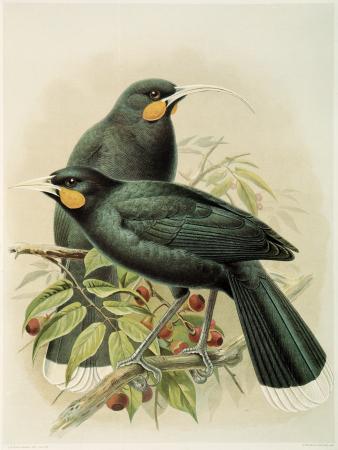When humans first arrived in Aotearoa, they found a place without land mammals of any kind, with the exception of two varieties of bat. Polynesians brought with them the kuri, a dog, and the kiore, a rat, both of which were used as food. For some reason two staples of Polynesian life, the chook and the pig, never made it. It didn't matter: those early arrivals found a strange place where most ecological niches had been filled by birds. The top predator was an enormous eagle that preyed upon the top grazer, the moa, a flightless bird a bit like an ostrich which came in all sizes from huge down to merely goose sized. There were carnivorous parrots, ground dwelling parrots, burrowing sea-birds that shared their homes with an ancient suriving dinosaur, the tuatara and many other marvels. Most varieties of bird had developed giant forms and these were quickly hunted to extinction by those early future eaters. The giant eagle died when its prey, the giant moa, was gone. What was left, was, mostly, songbirds. Birds of extreme and subtle beauty of plumage, which I will not even try to describe and, concomitantly, birds who sang beautifully: notably the bellbird, or korimako, whose massed dawn choruses are spoken of with wonder by those who have heard them.

Of the birds that remained after those early extinctions, the one most prized by Maori was the huia, a forest dweller whose white tipped tail feathers were used as insignia by the high-born. The huia is also extinct, but it disappeared almost within living memory, a casualty of shrinking habitat and human profligacy, in this case of European collectors who shot the chiefly bird with insoucient abandon throughout the 19th century, so as to preserve specimens of it. In my youth I used to mourn the huia like I now mourn those lost cards, and fantasise that someday, in some forgotten pocket of bush, a breeding pair would be found again. This seems unlikely. However, among my books is a de luxe edition of Buller's Birds of New Zealand which my mother gave me many years ago. The coloured plates in this book, including a very lovely pair of huia, are as beautiful as those cards in my memory, and I sometimes try to persuade myself that the cards were in fact only a portable version of Buller. But it isn't so; they were different pictures, more homely perhaps and anyway there was something marvellous about the way you could actually handle as well as look at them. And they presaged - what? Hard to say, beyond a lifetime of pleasure in the company of birds.

2 comments:
My father believed he heard a huia during his childhood in the Marlborough Sounds, nearly a hundred years ago - christ it sounds strange writing that. He has always stressed that it might have been; however, his description of the call was such that he has been reported in at least one book about the history of the huia to have been the last person to hear its call.
That's amazing ... ! What he would have heard: " ... a soft and clear whistle, at first prolonged then short and quickly repeated. When excited or hungry, raised ... to a high pitch; at other times ... softly modulated, with variations, or changed into a low chuckling note. Sometimes their cry resembled the whining of young puppies so exacty as almost to defy detection." (Buller)
Post a Comment